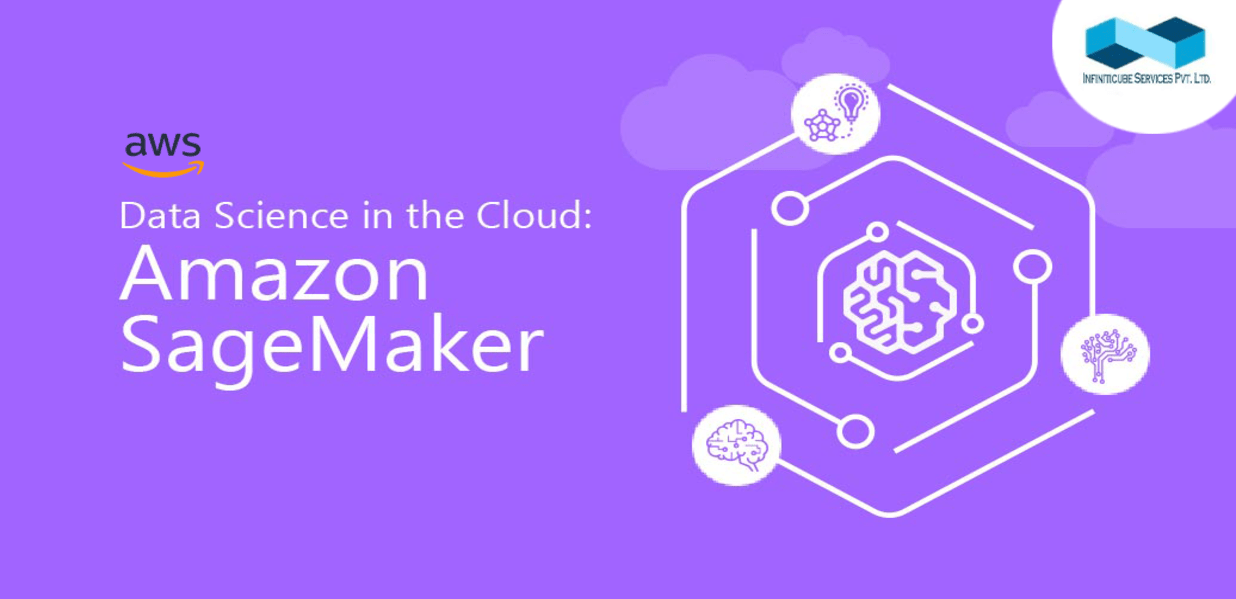How AWS SageMaker Ensures Reliable Impact On Machine Learning Developers And Data Scientists?
Many data scientists use the hosted environment to develop, train, and deploy machine learning models. Unfortunately, they lacked the ability to scale up or scale down resources as needed. AWS SageMaker addresses this issue by allowing developers to build and train models in order to get to production faster and at a lower cost.
If you are looking for scalable Model Deployment via AWS SageMaker, you should definitely contact Infiniticube or schedule a call with a Sagemaker expert by clicking here. Our Expert will gladly assist you in resolving your issues and providing the best services possible.
And, before we get started with SageMaker, here's a primer on "What is AWS?"
Amazon Web Services (AWS) is a cloud platform that provides on-demand internet services. Any type of cloud application can be created, managed, and deployed using AWS services. In this case, it may be useful.
Introduction to AWS Sagemaker
A serverless architecture makes the runtime inference endpoint available to consumer device client software. REST is a user-friendly web-based protocol for connecting the inference endpoint to the larger enterprise application.
The path from proof of concept to production is long and difficult. Sagemaker is a sophisticated Machine Learning platform that provides a wide range of capabilities for managing large amounts of data to train the model, selecting the best algorithm for training it, managing infrastructure scalability and capacity while training it, and finally deploying and monitoring the model in a production environment.
Amazon SageMaker is a fully managed service that allows data scientists and developers to rapidly create, train, and deploy machine learning models of any size. Amazon SageMaker includes modules for building, training, and deploying machine learning models that can be used together or independently.
AWS SageMaker Machine Learning
It automates time-consuming manual processes while minimizing human error and hardware costs. Machine learning modeling components are included in the SageMaker tool set. SageMaker templates abstract software capabilities. They offer a framework for building, hosting, training, and deploying machine learning models at scale in the Amazon public cloud.
SageMaker enables any developer or data scientist to quickly build, train, and deploy machine learning models. Amazon SageMaker is a fully managed service that manages the entire machine learning workflow, from data labeling and preparation to algorithm selection, training the model, tuning and optimizing it for deployment, making predictions, and acting. Your models are created much faster and at a lower cost.
How does Amazon SageMaker function?
AWS SageMaker divides machine learning modeling into three steps: preparation, training, and deployment.
Preparation
Amazon SageMaker creates an Amazon Elastic Compute Cloud fully managed ML instance (EC2). It is compatible with the open-source Jupyter Notebook web application, which allows developers to share live code. SageMaker runs Jupyter notebooks for computational processing.
Drivers, packages, and libraries for popular deep learning platforms and frameworks are included in the notebooks. Developers can use AWS to launch a prebuilt notebook for a variety of applications and use cases. They can then tailor it to the data set and schema that need to be trained.
Custom-built algorithms written in one of the supported ML frameworks or any code packaged as a Docker container image can also be used by developers. SageMaker can retrieve data from Amazon Simple Storage Service (S3), and the data set has no practical limit in terms of size.
A developer begins by logging into the AWS SageMaker console and launching a notebook instance. SageMaker comes with a number of built-in training algorithms, such as linear regression and image classification, or the developer can import their own.
Train and Tune
The location of the data in an Amazon S3 bucket and the preferred instance type is specified by model training developers. They then start the training process. SageMaker Model Monitor provides continuous automatic model tuning to determine the best set of parameters or hyperparameters. During this step, data transformation takes place, to allow for feature engineering.
Deploy and Analyze
In order to deploy the model, the service operates the infrastructure of the cloud in an automatic and scalable manner once the model is ready. It makes use of a variety of SageMaker instances as well as Graphics Processing Unit(GPU) accelerators designed for machine learning workloads.
SageMaker deploys across multiple availability zones, performs health checks, applies security patches, configures AWS Auto Scaling, and creates secure HTTPS endpoints to connect to an app. A developer can use Amazon CloudWatch metrics to track and trigger alarms for changes in production performance.
What features does SageMaker have?
SageMaker has received additional features from Amazon since its initial release in 2017. The features are available in AWS SageMaker Studio, an Integrated Development Environment (IDE) that combines all of the capabilities. The features are
- Advantages of Serverless Inference
- More Rapid Model Development And Deployment
- Cost Savings
The Advantages of Serverless Inference
SageMaker, Amazon's fully managed machine learning service, aims to assist in situations where traffic patterns are unreliable. SageMaker's main advantage is that it lowers the total cost of ownership (TCO). Users will not need to configure or manage the underlying infrastructure when deploying machine learning models for inference with SageMaker. SageMaker can automatically offer and scale compute capacity based on the number of inference requests.
More Rapid Model Development and Deployment
SageMaker allows users to select from a library of commonly used pre-built models, allowing them to begin training and making inferences much faster. Nucleus polled customers, who reported a 33 to 50% reduction in time to inference (the time it takes from model creation to training and tuning to produce predictions on live data).
Cost Savings
Customers saved money by using a fully managed machine learning service. After migrating workloads to SageMaker, some businesses were able to save up to 80% on machine learning-related hardware and resources.
Amazon SageMaker Studio's automation tools assist users in automatically debugging, managing, and tracking ML models. These SageMaker tools include the following:
Autopilot
You can use autopilot to train AI Models on a given data set and rank each algorithm in terms of accuracy.
Clarify Flags
It has the potential to introduce bias into ML models.
Data Wrangler
You can use Data Wrangler to expedite data preparation.
Debugger
It monitors neural network metrics to make debugging easier.
Edge Manager
It extends ML monitoring and management to edge devices.
Experiments
It makes it easier to track different ML iterations, including how changes degrade or improve a model's accuracy.
Ground Truth
When processing large AI training samples, it accelerates data labeling and helps to reduce labeling costs.
JumpStart
It provides an AWS CloudFormation template library that is pre-designed and editable.
Model Monitor
It is a machine learning tool powered by AWS that detects application-level deviations that reduce prediction accuracy.
Notebook
It generates Jupyter notebooks automatically and transfers notebook content for collaborative use.
Pipeline
Developers can use pipelines to get machine learning services for continuous delivery and integration.
What are SageMaker application scenarios?
AWS SageMaker is a cloud-based service with a wide range of applications for a wide range of industries. Data science teams use SageMaker to do the following:
- Improve data training and inferences
- Iterate more accurate data models
- Optimize Data Ingestion and Output
- Gain Access To and Share Code
- Accelerate the development of production-ready AI modules
- To process large data sets
- Modeling Code Sharing
Notable brands use SageMker in the following industries, according to Amazon:
- Hospitality
- Cloud computing services
- Entertainment and media
- Analytical data
- Pharmaceuticals
- The earth sciences
- Publishing
- Electronics
- Retail \sEnergy
- Service and software
- Insurance and finance
- Transportation
- Healthcare
- Gaming and video games
Is SageMaker a safe program to use?
Thanks to AWS SageMaker's integration with S3, now you can store your data for testing, training and validation in a collaborative data lake. Because of this, now users can securely interact with data using the AWS Identity and Access Management framework.
Using the AWS Key Management Service, Amazon SageMaker can optionally encrypt models in transit and at rest. API requests are routed to the service via a secure sockets layer connection. SageMaker also stores code in password-protected and encrypted volumes.
For increased data security, customers can run SageMaker in an Amazon Virtual Private Cloud. It is because this method gives you more control over the data that flows to SageMaker Studio notebooks.
How does SageMaker's pricing work?
Machine learning models and predictions previously cost each SageMaker user for computing, storage, and processing resources. In addition, the S3 resources were charged to customers for storing training and ongoing prediction data.
As of today, there are two ways to pay for a service: on-demand pricing and flexible pricing. Whereas, Amazon charges by the second and does not require a minimum fee or an upfront commitment.
Amazon launched the AWS SageMaker Savings Plan in April 2021, which offers flexible pricing for instance types eligible for SageMaker ML as part of its flexible pricing program. According to Amazon, the savings plan allows customers to save up to 64% on purchases.
Customers must agree to consume a certain amount of capacity, measured in dollars per hour, for at least one year in order to qualify for the discount.
SageMaker is available for free on the AWS Free Tier. Customers only pay for Amazon services that they use within SageMaker Studio.
AWS' main public cloud competitors provide similar services for developing ML-enabled infrastructure. Google Cloud Foundation includes Google Vertex AI. In addition to these services, Microsoft Azure also provides Azure Machine Learning as a free service.
If you require scalable Model Deployment via Amazon SageMaker, get in touch with Infiniticube. Our Team of Experts has not only implemented numerous sophisticated ML models for a variety of industries on Sagemaker but we are helping clients save up to 70% on the costs of AI/ML infrastructure as well. Here are a few models that we created specifically for AWS Sagemaker and deployed.
- Models for the mortgage industry
- NLP Models
- Computer Vision Models
- Social Listening Models
- Health record analysis models
- IoT Data Analysis models
Reach out to us right away if your machine learning team wants to lower costs and deploy highly scalable server-less models. You can leave your requirements or schedule a call with one of our AI specialists.
 June 13, 2025
June 13, 2025
 Balbir Kumar Singh
Balbir Kumar Singh
 0
0
 May 30, 2025
May 30, 2025
 Balbir Kumar Singh
Balbir Kumar Singh
 0
0
 June 27, 2025
June 27, 2025
 Balbir Kumar Singh
Balbir Kumar Singh
 0
0
 June 13, 2025
June 13, 2025
 Balbir Kumar Singh
Balbir Kumar Singh
 0
0
 May 30, 2025
May 30, 2025
 Balbir Kumar Singh
Balbir Kumar Singh
 0
0
 June 27, 2025
June 27, 2025
 Balbir Kumar Singh
Balbir Kumar Singh
 0
0
 June 13, 2025
June 13, 2025
 Balbir Kumar Singh
Balbir Kumar Singh
 0
0
 May 30, 2025
May 30, 2025
 Balbir Kumar Singh
Balbir Kumar Singh
 0
0









Leave a Reply